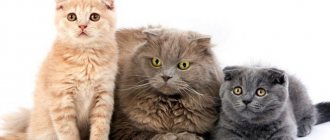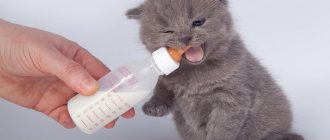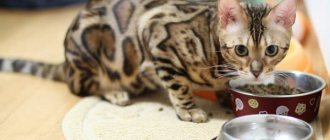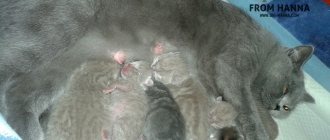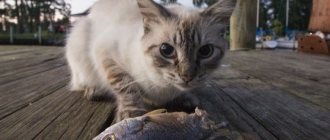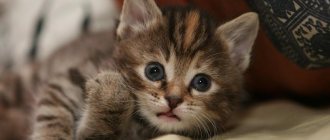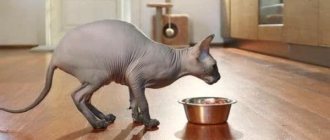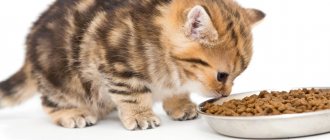If a long-awaited kitten adopted from a breeder appears in the house, the question of its age does not even arise, because the day of its birth is precisely indicated in the passport. It is somewhat more difficult with kittens purchased at the poultry market, because an error of a couple of weeks is possible. What to do if your heart trembles at the sight of a street stray and you are ready to shelter such a cat? How to determine the age of a cat if it comes to you no longer as a cute kitten? This is not an idle interest, but a matter of the health of the cat and all households. Certain diseases or behavioral changes in cats occur at specific ages, so it is necessary to prepare for them. A phenologist can easily determine the age of an animal, but it is not always possible to contact him, so we will try to learn how to do this at least approximately.
TO find out the age, you need to carefully and slowly examine the pet
Solving an equation with unknowns
Graceful representatives of felines have a rare property that many people would envy: years hardly reflect on them, and with a superficial examination it is almost impossible to find out their age (unless, of course, it is a charming kitten). From a year to almost 10 years, the animal’s life continues to flourish, and maturity begins almost imperceptibly. This brilliant form often confuses potential owners. They look for information in bewilderment, trying to understand what signs can be used to determine the age of a cat. Of course, if the date of birth is known at least approximately, this problem can be easily solved by simple mathematical calculation. But what if this is unknown? What if the time period from birth to the appearance of a cat in the house is also unknown? This already looks like higher mathematics, forcing you to solve an equation with many unknowns.
As cats approach one year of age they become calmer
To get an answer, you will have to carefully and slowly examine your new pet. The condition of the teeth, eyes, fur, habits and habits - all this changes gradually. And the process of change is described in some detail. So, by analyzing the data of external examination and observations of behavior, you can quite accurately determine the age of the purr.
Where to buy and the price of such kittens
It is rare, but you can find 8-month-old Scottish cats on sale. Usually everyone is taken away at 2-3 months, less often at 4-5 months, but if the cat is free at 8 months, you need to take an interest in its history and find out whether it has already been returned to the breeder for some reason. In any case, you should be wary and investigate. Perhaps the cat has some kind of genetic defect or behavioral problems.
In addition, an 8-month-old animal is almost an adult and will take longer to get used to you than a small kitten. However, even adult cats become attached to their new owner.
In addition, if you want to purchase an animal for breeding, it is better to buy an older one, because... It’s already roughly clear what grew out of it. By this age, the male or female cat has most likely already visited an exhibition with the breeder and received expert assessments. Accordingly, their price could increase. However, if you want more confidence that the purchased animal is suitable for breeding, then 8 months of age is better for purchase than 3 months.
Rate and share!
Behavior Observation
This is a very indirect sign, so it is problematic to find out the real age only by observing the life and habits of the animal. In addition, the cat’s temperament, breed, condition and environment have a certain influence. So is it possible to determine the age of a cat by its behavior? For sure - no, rather, this is a clarifying factor.
Kittens are the most active
A young animal is much more active than an older one. The highest activity is in kittens who are ready to play, jump, and tumble all day long. As they get closer to a year, they become calmer, although some breeds are famous for their playfulness at a very mature age. A cat older than a year will prefer to lie down imposingly on a sofa or windowsill, condescendingly watching what is happening.
An older animal sleeps much more and prefers not to move in vain. But a sick animal will behave in approximately the same way, preferring peace. Therefore, behavioral factors alone will not give an accurate answer to the question of how to determine the age of a cat.
An older animal sleeps much more
Rules for caring for a 3 month old kitten
Every British dog owner needs to know and control all aspects of caring for their pet. These include:
- Wool and keeping it looking good;
- Kitten hygiene at 3 months;
- Early castration and sterilization.
Grooming at 3 months
An important part of keeping your 3-month-old British kitten looking good is proper handling of its coat. At the same time, you need to take into account some established rules and adapt them to suit your pet. Although representatives of this breed are clean and very neat animals, they need to be bathed when they get dirty or before important exhibitions. At the same time, it is worth giving preference to high-quality, which, unfortunately, are not very cheap, cat shampoos
© shutterstock
Keep in mind that caring for a three-month-old British kitten is largely demonstrated by its appearance, and it is the fur that is the first demonstrator.
Therefore, in addition to timely bathing, to maintain the high-quality appearance of a British dog’s coat at 3 months, he needs to be given special vitamins. Such tablets or powders can be found on the shelves at a regular pet store, but it is advisable to consult a veterinarian before purchasing them. Also important purchases will be a comb and hair removal paste, which will be useful during shedding in the future.
Puberty
Attention! You can find out the age of pets by the moment of puberty.
This is possible if you take into your home a fairly young animal, barely out of kitten age. For such a case, you need to know how to determine the age of a cat up to a year. Males are known to begin showing interest in cats at around 7 months of age. They “mark” their territory more actively and can begin to quite loudly declare their desire for love.
Kitties “mature” around 8-9 months. But some females can begin hunting as early as six months. As you can see, this method of determining age is also not very accurate. The error can reach almost 3 months.
You can find out the age of pets by the moment of puberty
Teeth, eyes, paws
A more accurate method of determining the age of a cat is to examine its teeth. The cat is unlikely to be delighted with such a procedure, so before the examination it is better to play it safe and wrap it in a cocoon of blanket. Once the sharp clawed paws have been neutralized, gently grasp the cat's head with one hand and use the fingers of the other to gently push back the edge of the lip while inspecting the teeth.
At about 4 weeks of age, kittens begin to develop their first teeth. These are incisors. These will be followed by canines and premolars (should appear at about one and a half months). By 4 months, the molars will also come out. Almost immediately after this, the replacement of infant milk teeth with permanent ones will begin.
You can determine the age of a cat by the condition of its teeth.
Unlike people, cats go through this period quickly. Already at 7 months, baleen-tailed animals proudly demonstrate a full set of sharp and strong teeth - there should be 30 of them. Four canines, the same number of molars, 10 premolars and as many as 12 incisors. They are very white, very sharp and very strong. And they have absolutely no signs of abrasion.
Experts will tell you exactly how to determine the age of a cat by looking at its teeth after a year, when the inevitable process of their destruction begins. The teeth begin to turn yellow, the enamel wears off, and they gradually fall out. This happens approximately in this sequence:
- cat 2 years old: yellowing is barely pronounced, the central incisors on the lower jaw are worn away;
- from 3 to 5 years: yellowness is more noticeable, the incisors of the upper jaw wear out, the first signs of abrasion appear on the fangs;
- from 5 to 10 years: the teeth turn significantly yellow, the outer incisors at the top and bottom wear off (sometimes they even fall out);
- after 10 years: the teeth are very yellow, many may be missing. And if fangs are lost, the cat is clearly older than 15 years.
With age, the clear lens of a cat's eye becomes cloudy and dull.
Attention! When assessing the condition of the teeth, one should take into account the bite and the condition of the oral cavity itself.
If the diet was poor, dental care was not taken, and the bite was initially incorrect, the teeth will turn yellow and wear out much earlier. If you understand how to determine the age of a cat by its teeth, photos of normal and “non-standard” situations in the cat’s mouth will be a good hint. After all, in different breeds the structure of the muzzle is radically different, as is the bite, and not every cat can boast that its nutrition was balanced, its teeth were brushed and regularly examined at the veterinary clinic.
Many cat lovers will tell you how to determine the age of a cat by its eyes. It's not even about the sparkle of curiosity and mischief that is inherent in young cats. With age, the clear lens of a cat's eye becomes cloudy and dull. The iris loses its brightness and spots appear on it. But it is almost impossible to link these changes to a specific age.
https://youtu.be/sffK5XP0Bfw
Determining the age of the kitten
The most common reason for trying to estimate the age of pets is the decision to adopt a stray baby or adult cat.
If you need to determine the age of a kitten, it is enough to evaluate its development , and this is very simple. Suppose you found a squeaking lump, brought it home and are at a loss about what to do next... what to feed it, should it be warmed, how to care for it? The answers to all these questions depend on age, and it is determined by a number of characteristics.
Umbilical cord
Examine the kitten's abdomen, is the umbilical cord still in place? This means that you are dealing with a newborn baby who will not survive without proper care. On the first day the umbilical cord is wet, on the second day it dries out a little, and on the third (usually) it falls off.
At home, with proper complementary feeding, heating and care, a newborn kitten has a chance (not a guarantee) to survive. On the street, such a baby will die within 10–20 hours.
Eyes
At the first stage of development, two stages of the formation of a kitten’s eyes can be distinguished: the opening and acquisition of pigmentation. In newborn kittens, the eyes are closed, not glued together, but covered with a single flap of skin. The older the kitten, the more visible the furrow becomes, which will divide into the upper and lower eyelids.
The eyes open slowly, one at a time, and this process should never be forced. Glued eyelids are a defense mechanism. While a kitten's eyes are closed, they are not ready to perceive the outside world and are still developing. Depending on the breed and multiple births of the litter, newborn kittens open their eyes on days 7–14 of life.
Until about the 18th day, the eyelids are completely separated, and before this age, the eyes may appear too narrow or small. At this stage, the irises are not pigmented, the pupil is not clearly visible, and there is practically no accommodation (narrowing-expansion of the icon). The eye color appears very deep and ranges from dull gray to dull blue.
At the age of 6-8 weeks, the baby can already control his eyes, analyze information and follow objects. The period coincides with the first “forays into the world” in order to study the surrounding world. In a kitten older than 24 weeks, full pigmentation of the iris is formed and the pupil is clearly visible.
In blue-eyed cats, during the formation of pigmentation of the iris, the color becomes clearer (not cloudy), but practically does not change.
Ears
Ears are also a very clear indicator of the baby's age. Until 7–10 days of age, the ears are pressed down and seem to be glued to the head - this is a protective mechanism. By 8–12 days of age, the ears begin to open, but the tips of the cartilaginous plates are still curved.
Complete straightening of the cartilage plate can take up to 1.5 months, depending on the quality of nutrition and the timeliness of development. Don't be alarmed if your kitten doesn't respond well to sounds. The ear canals open by 8–10 days of age , but hearing at this time is not yet developed to the usual level.
Teeth
The most popular method of determining a kitten's age is by assessing its teeth. By assessing the condition of the dentition, you can determine the age from 2 weeks to a year, but there are a number of errors. Having brought a kitten from the street, you do not know what litter it was born in, whether it received enough nutrition, whether it was hypothermic, etc. The speed of teething is very dependent on the balance of metabolism. If the body lacks, for example, calcium, the teeth simply freeze, do not grow or change.
The complete absence of teeth indicates that the baby is not yet 14 days old. Tubercles, but not yet erupted baby teeth, appear by the 3rd week of life. At 4 weeks, small but very sharp fangs hatch. After the eruption of the canines, by 5–6 weeks, the incisors (front teeth) also appear. By 4 months of age, the baby has a full set of primary teeth.
You can distinguish baby teeth from molars by their size and the spaces between them. There are noticeable spaces between the baby teeth; they are thinner, smaller, and white or bluish in color.
From 4 months of age, the replacement of baby teeth begins , if the kitten is healthy and does not experience a deficiency of microelements. The incisors are the first to fall out and erupt. By the age of six months, the fangs and the teeth behind them change. By 7–8 months of age, all of the kitten’s molars have erupted, similar to wisdom teeth in humans. On the upper jaw, the molars are smaller than on the lower jaw.
Weight
If the kitten is healthy and visually well-fed, age can also be assessed by weight . Again, there are nuances - the innate constitution of the body (there are large and small cats), breed, heredity of development, multiple pregnancy, saturation of mother's milk, quality of complementary foods, living conditions, etc.
A newborn weighs little, up to 100 grams. and with normal feeding gains up to 20 grams. per day. The kitten rests completely on the average human palm for 7 days and, depending on its weight at birth, weighs from 120 to 170 grams. After two weeks, a healthy baby weighs approximately 250 grams. By 2 months of age, kittens are actively gaining weight and approaching the 0.9–1 kg mark. At this age, the baby is actively growing. The normal rate of weight gain is considered to be 0.5 kg per 30 days before reaching adult weight.
Depending on heredity and gender, active growth of a kitten continues up to 7–12 months.
Coordination and behavior
Until about 3 weeks of age, kittens do not walk, but crawl , periodically making attempts to rise to their feet. By the 3rd week, the baby can walk , he often skids, he falls to the side, and it is noticeable how his paws tremble. The situation improves within a week. During this same period, the baby begins to respond to sound stimuli, turn his head or walk in the direction of the sound source.
Most kittens develop the ability to fall on their paws at 4 weeks, this is due to the formation of the vestibular apparatus. Naturally, it is impossible to check age by the presence of this skill.
By 4 weeks of age, the kitten begins to explore the world, walks well and shows curiosity. The kitten's skills are improving every day, he learns to run, play, roll over, and pretend to fight. The kitten's confident running and ability to maneuver indicates an age of 5 weeks or more. By the age of two months, the so-called baby time begins, when the baby climbs into all the cracks, tastes the world, willingly contacts people, constantly moves and plays.
Puberty
Puberty is an important stage of development and growth . This indicator is determined to better understand the behavior of the ward, for example, for sterilization. The first prerequisites for puberty are visible externally, the cat becomes more graceful, that is, it already looks more like an adult than a cute, round baby.
By the age of 4 months, the testicles of males descend into the scrotum (this can be determined by touch). Further, the “young man” experiences a hormonal storm, and, guided by instincts, begins to mark his territory. Castration of males is allowed at an early age, immediately after the testicles descend into the scrotum. According to veterinarians, the optimal period is from 4 to 6 months. From 6 months of age, a young cat actively fights for territory and can not only mark, but also bite.
A cat at the age of 4 months is able to fertilize a female.
With cats it's a little more complicated. The process of puberty can be determined only by behavior or the onset of estrus. Usually, the first heat occurs at the age of 6–7 months and if at this time the cat meets a male, she will become pregnant. By 7 months, a cat is considered sexually mature, regardless of gender. This is also expressed externally - cats “mater”, cats become sophisticated and graceful.
We evaluate shapes and wool
There is another way to determine the age of a cat by external signs - assessing the condition of the coat and musculoskeletal skeleton. This is a very approximate method; it only allows you to determine whether the animal in front of you is young or already elderly.
Young pussies flaunt thick and shiny fur. Its villi are brightly colored; if there is a pattern, it is expressed quite clearly. Cats are lucky here too; they do not go bald with age, like humans. But the years make the coat thinner and duller. Gray hair becomes noticeable on dark skins.
Young pussies flaunt thick and shiny fur
An assessment of your overall physique will provide approximately the same amount of information. Teenagers are usually somewhat awkward, lanky and thin. Strong and flexible muscle relief is characteristic of active young animals. More mature individuals lose clear muscle definition, become rounder, heavier, and become “loose.” The muscles dry out, and old cats look thin and flabby, their shoulder blades protrude, and their backs sag.
Sometimes other methods are used. Have you heard how to determine the age of a cat by its paw pads? If in kittens they are very tender, silky, “untrodden”, then in older animals the skin of the pads gradually thickens, becomes a little coarser, and becomes a little rough. By the age of ten, the paw pads may even crack, especially if the cat has not had proper and nutritious nutrition.
More mature individuals lose clear muscle definition
Type of food and its features
A very important question is what to feed a British kitten for 3 months - ready-made food or natural food. When choosing the first option, you need to know that one manufacturer must be maintained throughout the development of the kitten, since each food has its own specific set of nutritional values and ingredients. If such a set changes, the British body may not yet be formed and refuse to accept the new food. If you choose natural food, it is worth noting that it is important to know the nuances of what you can and cannot give to your pet.
In addition, if you have chosen the option of buying a kitten in a nursery, then you need to inquire what method of feeding was chosen there for your animal.
Because it is advisable to continue to use the same dry food, but certain preferences may have already developed towards using a natural product.
Compared to a person
Many owners like to “convert” the age of their pets to human age. It is believed that ideally you should simply multiply the cat's age by seven, but this will give an accurate result if the cat is under 5 years old. Phenologists have compiled a special table that clearly shows how to determine the “human” age of a cat.
The count starts from six-month-old kittens, which are compared with three-year-old children. At 2 years old, the cat is fully formed - this is approximately 14 years in humans. Four years is equal to 28 years - this is the peak of a cat's capabilities. Then the time period shortens somewhat, a cat year is already equated to four human years: 5 years of an animal - 32 in humans, 7 years - 40, 9 - 48, 12 - 60. After 12 years in cats, “a year goes by in three.”
Cat age chart by human standards
Attention! Cats live much shorter than humans, but if you compare their age with humans, they will be long-lived.
On average, a healthy cat lives about 15 years, that is, almost 70 by human standards. But very often animals are able to reach the age of 20 and even 30 years. Did you recalculate according to the table? That's 130 years according to our clock! People of this age can be counted on one hand.
Everyone has a good idea of what people look like at that age. Therefore, there is nothing strange when our pets’ hearing suddenly decreases, their vision deteriorates, their general well-being suffers and many diseases develop. The animal sleeps more and eats poorly. But some “oldies” remain sociable and playful to the end.
On average, a healthy cat lives about 15 years.
This is possible if the content is worthy and the owner is attentive. Such an owner will probably figure out exactly how to determine the age of a cat and what specific amendments should be made to its diet and daily routine. And then the pet’s health will remain excellent for a long time, he will be cheerful, active and will be happy to communicate with you.

